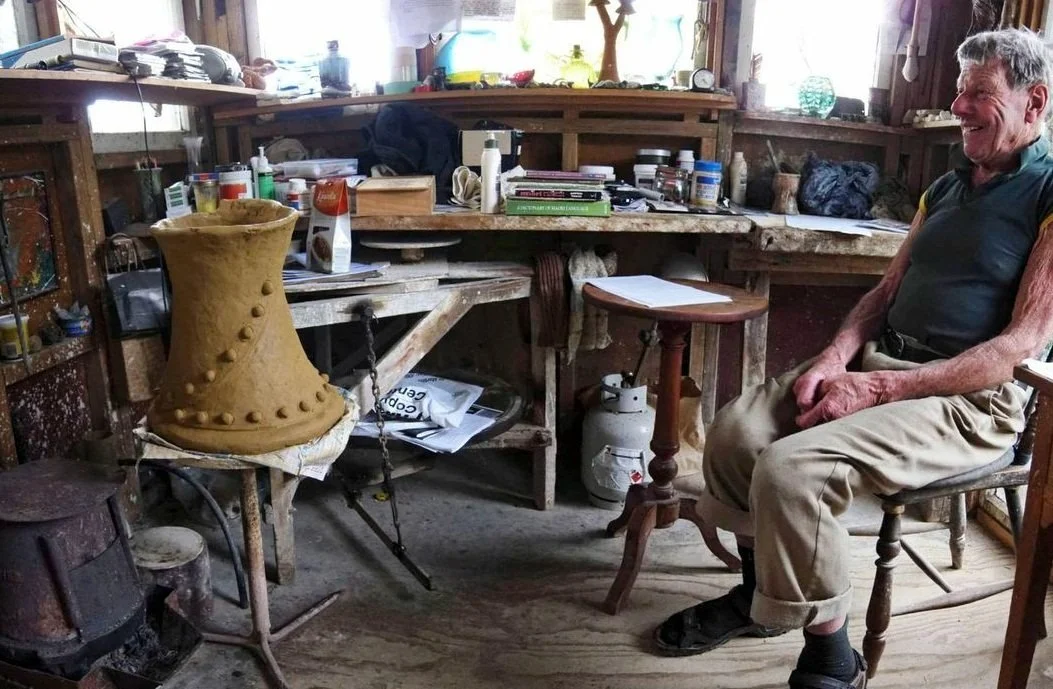A Community of Potters
Barry Brickell with his new sculpture, and Stradivarius. Courtesy of The Dowse Art Museum. Photo: Haru Sameshima
During the 1940s and 1950s studio pottery in Aotearoa New Zealand flourished, continuing in popularity until the 1980s. Economically, this can be attributed to import restrictions of the time, creating favourable conditions for local production. However, without potters forming their own sense of community, there would have been little opportunity for the medium to grow as it did.
Together, through experimentation, trial and error, potters found, prepared and shaped local clays—building kilns to fire their creations. Barry Brickell in the Coromandel; Yvonne Rust in Christchurch, Greymouth and Northland; Ian Smail in Auckland and Ross Mitchell-Anyon in Whanganui, all set up potteries and initiatives that nurtured potters and became important meeting places, where like-minded makers could share their knowledge.
It was not until the 1970s and 1980s that tertiary institutions started offering ceramics through visual or applied arts qualifications. Before this, the only way to learn how to pot outside of teachers' training college was through adult education programmes at summer schools or weekend and night classes.
Having led such workshops in Auckland in the late 1950s, Barry Brickell (1935-2016) left the city in 1961 to set up Driving Creek Railway and Potteries in the Coromandel. Here, he combined his passion for pottery, locomotive engineering and ecology. Outside of maintaining his own practice, he ran courses and took on apprentices, hosted numerous important national artists and potters, as well as international makers—who were often also enlisted to help build his railway. Of this special place he wrote:
The Potteries were set up as a communal studio, where people could come and learn the craft. [A national first], was the building of a wood-fired kiln stoneware kiln in 1974 that could reach 1300 °C, using waste slabs of dry pine from the local sawmill as fuel. Potters from around the country who were using oil, electricity or gas to fuel their kilns, came to learn the gentle art of wood firing. [1]
Brickell became one of the earliest professional potters in New Zealand, and his extensive research of geology and engineering saw him travel around the country to share his knowledge of kilns. On one such trip in the early 1960s, Brickell showed a determined Yvonne Rust (1922-2002), still early in her career, how to properly fire her home-made kiln at The Studio of Design, which she had established in Christchurch. Rust recalls the atmosphere there:
[It] was open at any time, day or night for people to learn or practice…many students did their own thing at the Columbo street studio. We would be firing the kiln on a Saturday night and then would go off and get the ingredients to make bread in the early hours of the morning. They would drink wine and dance. The place enjoyed itself, yet they all worked hard. [2]
Enticed by the rich sources of clay on the South Island’s West Coast, Rust moved to Greymouth in 1967 where she taught secondary and adult students at the local high school. She also established a pottery in the old Stewarts’ Brewery, where Brickell built her a kiln and many students came to learn, make and fire their work. In 1972, Rust moved back to Northland (where she was born), to establish the Quarry Arts Centre in the former Waldron Quarry, with the help of the Government’s Project Employment Programme. Rust’s passion for ceramics education and her belief in the ability potting gave people to express themselves with local, raw materials, saw her become a significant mentor in New Zealand ceramic history.
By the 1970s, many more potters were working professionally. Having taken up pottery night classes at Glenfield College with his mother-in-law, in 1973 Ian Smail (b.1949) quit his job as a laboratory technician and bought a 10-acre block of land on Auckland’s North Shore with his wife Sheryl. There he built their home, studio and a baby oil-fired brick kiln, powered with an old petrol motor. They named the property Nodsdale and began inviting Ian’s fellow students such as Merilyn Wiseman, as well as teachers such as Chester Nealie, to use his kiln. Over the years Smail built two more kilns, having makers such as Warren Tippet stay long term on the property and hosting numerous others such as Len Castle, Bronwynne Cornish and Dennis O’Connor. While Nodsdale had become a hub for potters in Auckland, in 1984 the Smail's left for Whanganui.
Having become a regional art hub, Whanganui was also where Ross Mitchell-Anyon (b.1954) was based. He trained at the Palmerston North Teachers College in 1975, and went on to teach at Whanganui UCOL’s Diploma in Ceramic and Design production. A significant contributor to the city’s creative reputation, Mitchell-Anyon built his home and pottery on the Whanganui River’s bank. Establishing a practice based on multiple runs of domestic items such as mugs, tea pots and jugs he sourced his clay from Pahiatua, at a location he found while studying. His home became a gathering place for the artistic community, where he and his wife Bobbi hosted many parties. Outside his lecturing, Mitchell-Anyon cultivated an informal learning environment, taking on apprentices and students at his home, which contributed to a new generation of successful makers such as Martin Popplewell and Paul Maysek.
Formal, tertiary education in ceramics practices, have fallen in and out of favour since the late 20th century—a reflection of the government’s removal of import tariffs and changing tastes. Regardless of these conditions, much of the progress made in the field has come from ‘meeting places’ such as these, a result of the eagerness to learn in a grass roots environment and the generosity of spirit passed down between generations of potters.
***
This text was originally written in 2018, for the Crafting Aotearoa project, in association with Auckland Museum.
***

